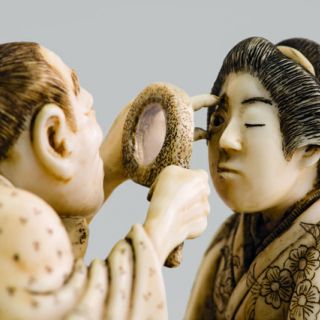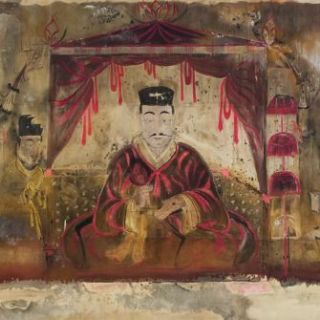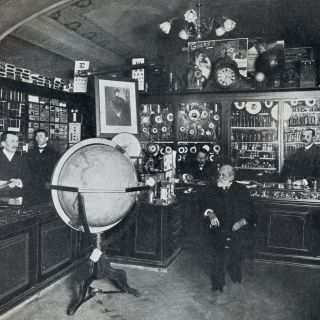Search: "Tibor Horváth" - 24 result(s)
Japanese Collection
… Fettick, Nándor Montenuovo, Béla Ágai and his wife, László Passuth, Zoltán Felvinczi Takács and Tibor Horváth through the objects they collected. The oldest pieces of fine art in the collection are related to Japanese Buddhism. The earliest piece of sculptural art in the collection, a seated figure of Shaka Nyorai from the Heian period (795–1184), carved in wood, was collected by the Catholic bishop, Count Péter Vay when he was visiting missions in Asia. The Kamakura period (1185–1333) …
More ❯❯❯Korean Collection
… by the museum’s founder, Ferenc Hopp and the first two directors, Zoltán Ferlvinczi Takács and Tibor Horváth, on the basis of their East Asian collecting trips,. Ferenc Hopp visited Korea on his third round-the-world trip in 1903. The only souvenir of this journey today is a nineteenth-century ceramic depicting Kannon. As a result of the conscious development programme that was initiated after the full survey of the museum’s holdings in 1950, the Korean collection was expanded through …
More ❯❯❯Archive
… The legacies of two further directors, the archaeologist, orientalist, and art historian Tibor Horváth, and Pál Miklós are also of great importance, as they contain documents of the era about the work in the museum. Among the most important personal bequests, the legacy of the Indologist, art historian, writer and museologist Ervin Baktay must be mentioned. Between 1946 and 1959 he was curator of the Indian Collection at the Hopp Museum. Besides, he was among the first to …
More ❯❯❯Korean Collection
… dynasty, second half of the 13th century Stoneware, celadon glaze, inlaid pattern Gift from Tibor Horváth, 1949
More ❯❯❯Korean Collection
… PATTERN Korea, 19th century; Porcelain with blue underglaze painting Gift from Tibor Horváth, 1949
More ❯❯❯Chinese Collection
… 15th century Grey porcelain, with pale green cracked glaze (Longquan ware) Collected by Tibor Horváth
More ❯❯❯History of Hopp Museum
… India, South East Asia, Nepal, Tibet, Mongolia, Korea and the Near East. The archaeologist, Tibor Horváth (1910–1972), appointed director of the museum in 1948, embarked on processing the collection, aided by outstanding experts, including several philologists with degrees in oriental studies. The museum was now divided into regional collections. Our museum has its own reference library, the only one in the country that specialises in Asian art, as well as the only documentation …
More ❯❯❯Library
… and researcher of Inner Asia, and an external member of the Hungarian Academy of Sciences; Dr Tibor Horváth (1910–1972), orientalist and archaeologist, whose books on Japanese art were mostly purchased in Japan; and the private library of Ervin Baktay (1890–1963), art historian, orientalist, and painter. The library recently acquired a substantial part of the collection of Japanese language and art-related books owned by the economist, Katalin Ferber (1952–), and many books on Indian and …
More ❯❯❯Archive
… in the Far East]) is inval uable when it comes to interpreting the photographs. Dr Tibor Horváth (1910–1972), archaeologist, orientalist, art historian, director of the Hopp Museum from 1948 to 1972. Besides his archaeological studies, he also earned doctorates in oriental history and the ancient history of Eastern peoples. He joined the Hopp Museum as an apprentice in 1939. In 1941 he earned a one-year study grant to Japan, but due to the outbreak of war, he did not …
More ❯❯❯History of the Library
… and researcher of Inner Asia, and an external member of the Hungarian Academy of Sciences; Dr. Tibor Horváth (1910–1972), orientalist and archaeologist, whose books on Japanese art were mostly purchased in Japan; and the private library of Ervin Baktay (1890–1963), art historian, orientalist, and painter. The library recently acquired a substantial part of the collection of Japanese language and art-related books owned by the economist, Dr. Katalin Ferber (1952–), and many books on Indian …
More ❯❯❯Special Collections
The Collection of Dr. Tibor Horváth Dr. Tibor Horváth (1910-1972), archaeologist, orientalist, and art historian, was director of Hopp Museum from 1948 to 1972. From 1939 he worked in the museum as an apprentice. Due to his remarkable publications that appeared between 1934 and 1940, his name was established as an authority on archaeology, which contributed to his winning a research fellowship in Japan for one …
More ❯❯❯






